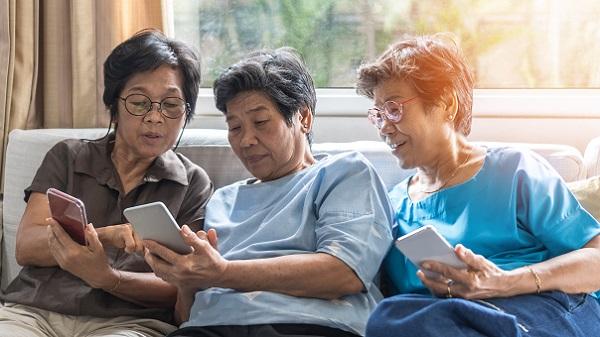Digital App Improves HF Quality-of-Care Metrics: CONNECT-AF
The app didn’t improve clinical outcomes but did show promise in terms of keeping patients on track with drug therapy.

(UPDATED) Use of mobile health technology can significantly improve the quality of care for patients discharged following hospitalization for acute heart failure (HF), according to a new analysis of CONNECT-HF.
Patients who used the digital application (HealthStar), which supports guideline-directed medical therapy (GDMT) and delivers personalized education, had an improvement in a composite score tracking HF quality-of-care metrics, but didn’t derive any reduction in their risk of hospitalization for HF or death, report researchers.
“Despite the smaller-than-anticipated sample size, our findings demonstrate a positive signal towards improving HF quality of care,” lead investigator Vishal Rao, MD (Duke Clinical Research Institute, Durham, NC), told TCTMD via email. “Digital application use was associated with both continued or [increased] use and adherence of guideline-directed medical therapy, device-based therapies, and participation in HF disease management programs. The largest associated benefit was in attendance of HF disease management programs.”
For Rao, the data suggest the app, or apps like it, could potentially lead to improved delivery of HF education and engagement in self-care. The study results also suggest there may be a “digital divide” between the technologically savvy and people who are unable, or not inclined, to use mobile health applications.
Presenting the CONNECT-HF data at the Heart Failure Society of America (HFSA) 2021 meeting in Denver, CO, Rao noted that patients hospitalized for acute HF are frequently undertreated with GDMT. For example, the CHAMP-HF registry showed that while 80% of patients who have HF with reduced ejection fraction (HFrEF) are treated with beta-blockers, just 66% are prescribed ACE inhibitors/ARBs, only 34% are treated with a mineralocorticoid receptor antagonist (MRA), and less than 15% are prescribed an angiotensin receptor-neprilysin inhibitor (ARNI).
Mobile apps hold the promise to improve healthcare quality measures, such as the use of GDMT, but there are limited data showing that these apps are effective. “While promising, digital health tools should have evidence from randomized clinical trials before widespread adoption,” said Rao.
Optional Digital Substudy
The CONNECT-HF trial was a 2x2 factorial randomized trial with four resulting arms: an HF quality-improvement intervention; the quality-improvement intervention plus use of the digital app; usual care alone; or usual care plus the app. The primary results of CONNECT-HF were published earlier this year, with investigators reporting that the hospital/postdischarge quality-improvement intervention did not improve clinical outcomes or quality of life.
To be included in the digital substudy, patients needed to have mobile internet access, a smartphone, and the ability to demonstrate some savviness with technology. For example, they had to show they could access the phone’s mobile operating system and download an app to check the weather. With the study app, patients received personalized education while tracking key metrics, such as medication adherence, physical activity, diet, and weight. Additionally, the digital intervention applied several principles of behavioral economics, which attempts to use psychology to account for behavior that isn’t always rational.
Rao said the app included social support via a “care circle” chat group where participants were paired with other patients (or could invite their own friends and family) and a commitment contract with which participants agreed to complete program activities like taking their medication and recording daily weights or else lose access to other apps on their phones.
Speaking at the HFSA meeting, Rao explained that the substudy was switched to an optional ancillary study because of concerns about the ability to randomize patients to the digital intervention. Of the 2,431 patients offered to participate in that ancillary study, 1,276 were able to use digital tools. Of these, complete data from the CONNECT-HF trial were available for 842 patients, but 486 participants declined the digital application (did not download the app and did not participate), leaving 356 included in the digital ancillary study with available data. From this group, 310 users were matched with 310 nonusers randomized to usual care in the main CONNECT-HF study.
From baseline, users of the digital technology had an improvement in the composite score that captured adherence to quality metrics for HF, up from 45.3% at baseline to 48.1% at 1 year. Comparatively, there was no change in the composite quality score among those treated with usual care. The adjusted between-group difference was 4.95%, which was statistically significant. Users of the digital technology had an improvement in most of the individual quality metrics compared to nonusers, said Rao.
In terms of the clinical outcomes, there was a trend toward a lower risk of HF hospitalization or death at 1 year among those who used the digital app, though the difference was not statistically significant (36.7% vs 41.4%; HR 0.84; 95% CI 0.65-1.07).
Thanks, but No Thanks
Rao said that use of the digital app declined over time, with just 68% of participants using the technology at 4 weeks. By 1 year, 29% were still using the application. However, the industry-standard user-retention rate for commercial health applications is roughly 14% at 1 year, said Rao.
In terms of why patients declined to use the technology—the number of people who didn’t want to participate surprised the researchers—Rao told TCTMD they are still teasing out the reasons, noting that there were no differences in baseline comorbidities, age, race, sex, or use of GDMT between those who participated and those who declined. He added that over 85% of patients in both groups (those who used the digital app and those who declined) had health insurance.
“It was unexpected that people who used the tool or did not use the tool did not necessarily have striking differences based on their baseline characteristics,” he said. “We still plan to further investigate the population differences in upcoming analyses, and perhaps future studies may investigate other social or behavioral characteristics between digital users and those who decline use in heart failure care.”
He added that the average age of patients in the digital substudy was 60 years, so older age is not necessarily the barrier. Instead, there may be subsets of that population who are disinclined to use technology as part of care, suggested Rao.
Michael O’Riordan is the Managing Editor for TCTMD. He completed his undergraduate degrees at Queen’s University in Kingston, ON, and…
Read Full BioSources
Rao VN. Association of digital tool use and heart failure care: CONNECT-HF. Presented at: HFSA 2021. September 13, 2021. Denver, CO.
Disclosures
- CONNECT-HF was funded by Novartis through an investigator-initiated trial program.
- Rao reports no relevant conflicts of interest.





Comments